Sugar Glider Diets and Recipes: Essential Guide for Owners
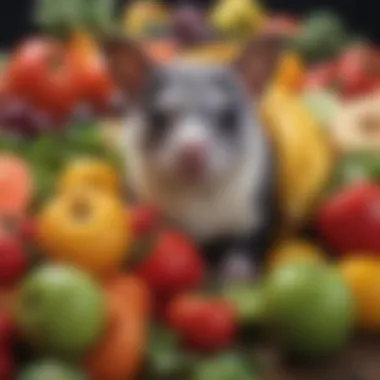
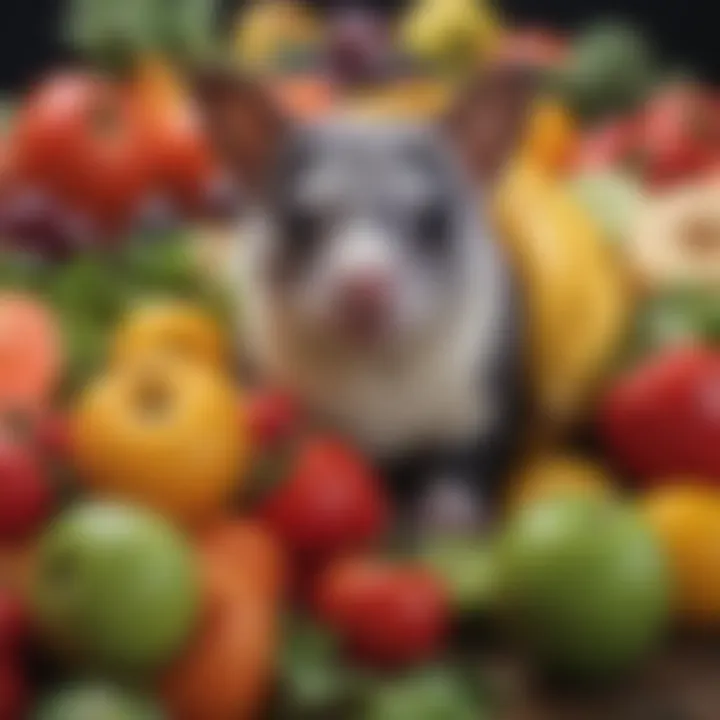
Intro
Understanding the dietary needs of sugar gliders is crucial for ensuring their well-being. These small, nocturnal marsupials come from Australia and New Guinea and have specific nutritional requirements that differ from more common pets. This guide delves into the intricacies of sugar glider diets, including what foods are suitable, how to prepare these meals, and the common mistakes pet owners should avoid.
By exploring these themes, readers will gain a comprehensive understanding of how to provide the right nutrition for their sugar gliders. A well-balanced diet is not only vital for their physical health but also significantly impacts their behavior and longevity.
Understanding Your Pet
Sugar gliders are unique creatures with specific needs. Recognizing the behavior patterns and nutritional requirements of these pets is key to creating a loving environment.
Pet Behavior Basics
Sugar gliders are social animals. They thrive in groups and have a natural instinct to bond with their owners. Understanding their behavior, such as their nocturnal habits, helps owners create a conducive environment. They require regular interaction and stimulation.
Common Breed Characteristics
While there are various types of sugar gliders, the most common breed is the grey sugar glider. They typically weigh between 4 to 5 ounces and have a lifespan of 10 to 15 years. Their soft, grey fur and large eyes make them appealing companions, but they are not low-maintenance pets.
Species-Specific Needs
Sugar gliders require a diet rich in fruits, vegetables, proteins, and calcium. Their nutritional needs should mimic what they would find in the wild. This means providing a variety of food items, since a single type of food can lead to deficiencies.
Pet Care and Maintenance
Feeding sugar gliders goes beyond simply providing food. Implementing effective care and maintenance practices ensures that they thrive in your home.
Feeding Guidelines
- Fruits: Offer a mix of fresh fruits like apples, bananas, and grapes.
- Vegetables: Include vegetables like sweet potatoes and carrots, which are good sources of nutrients.
- Protein: Incorporate items such as cooked chicken or mealworms.
- Calcium: Ensure a source of calcium, often in the form of specialized diets like the leadbeater's mix.
It's important to avoid foods like chocolate, avocado, and high-fat options as these can be harmful.
Grooming Essentials
Regular grooming is essential to keep sugar gliders healthy. This includes checking their fur for matting and trimming their nails to prevent overgrowth.
Hygiene Practices
Maintaining a clean habitat is vital. Regular cleaning of the cage and immediate pickup of any uneaten food will minimize odors and prevent illness.
Training and Development
Training sugar gliders can be challenging yet rewarding. Establishing commands and socializing them helps foster a bond.
Basic Commands and Skills
Start with simple commands such as
Understanding Sugar Glider Nutritional Needs
Understanding the nutritional needs of sugar gliders is crucial for their health and well-being. These small marsupials have unique dietary requirements that differ from typical pets. Proper knowledge about what they need ensures that pet owners can provide a balanced diet, leading to happier and healthier sugar gliders. Addressing their specific nutritional needs can prevent health problems commonly associated with improper feeding practices.
Basic Nutritional Requirements
Sugar gliders require a well-rounded diet that consists of proteins, carbohydrates, fats, vitamins, and minerals. Understanding these requirements helps in creating a diet plan that supports their energy levels and overall health.
- Proteins: Essential for growth and maintenance.
- Carbohydrates: Provide necessary energy.
- Fats: Aid in nutrient absorption.
- Vitamins and Minerals: Support various bodily functions.
These nutrients must come from a mix of sources to avoid deficiencies or imbalances.
Role of Protein in Their Diet
Protein plays a key role in the diet of sugar gliders. It is central to muscle development, the repair of tissues, and the production of enzymes and hormones. Sugar gliders in the wild obtain protein from insects and nectar. Pet owners should include similar protein profiles in their diet:
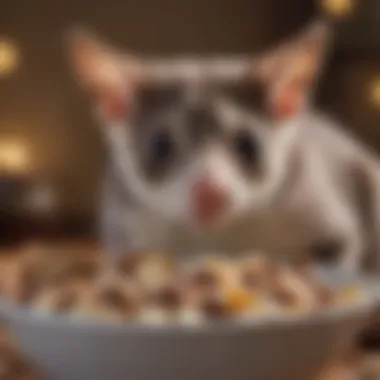
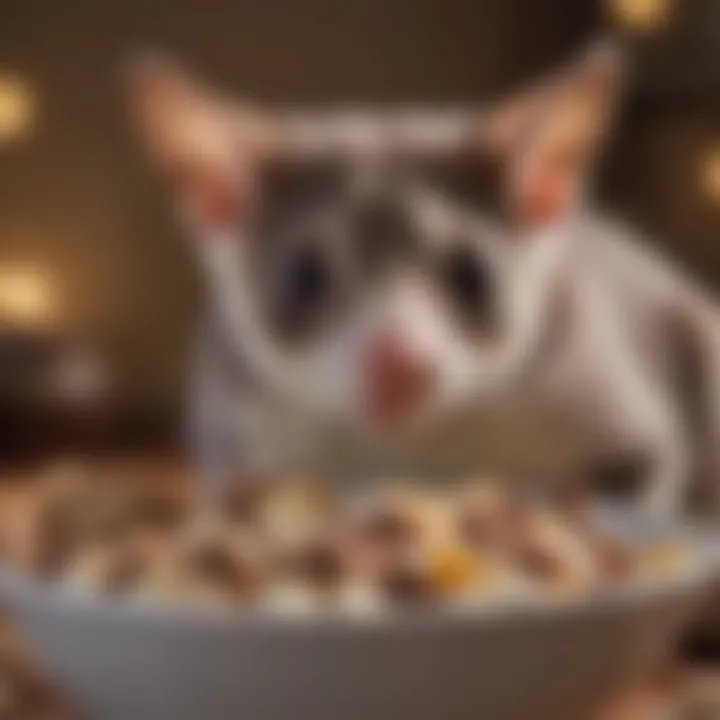
- Insects: Such as crickets and mealworms.
- Cooked Chicken: Offers a good source of protein.
- Soy Products: Like tofu, provide an alternative.
In addition to animal proteins, a proportion of plant-based proteins can create a comprehensive source of nutrients.
Importance of Calcium and Phosphorus Ratios
The balance of calcium and phosphorus is vital for sugar gliders. An incorrect ratio can lead to health issues, particularly with bone density. The ideal ratio should typically be around 2:1 (calcium to phosphorus). Calcium supports skeletal health and is crucial during growth stages.
Sources of calcium include:
- Leafy Greens: Such as kale and collard greens.
- Dairy Products: If tolerated, provide calcium.
- Calcium Supplements: Can help to balance the diet, ensuring adequate levels are met.
Incorrect ratios can lead to metabolic bone diseases, which are serious and sometimes irreversible.
Vitamins Essential for Sugar Gliders
Vitamins are crucial for powering biochemical processes within sugar gliders. Vitamins A, D, and E are particularly important.
- Vitamin A: Supports vision and immune function. Found in carrots and sweet potatoes.
- Vitamin D: Aids in calcium absorption; sunlight exposure helps, but supplementation may be necessary.
- Vitamin E: Acts as an antioxidant and supports skin health, found in nuts and seeds.
Incorporating fresh fruits and vegetables in their diet can help provide a diverse range of vitamins, ensuring sugar gliders receive a comprehensive nutritional profile.
Proper nutrition is the cornerstone of health for sugar gliders, impacting everything from growth to mood. Regular assessments of diet can prevent unforeseen health issues related to nutrition.
Types of Diets for Sugar Gliders
Understanding the various types of diets for sugar gliders is essential for pet owners aiming to provide a well-balanced and nutritious diet. Each type of diet has its own merits, drawbacks, and considerations that can affect the health and well-being of these unique pets. Addressing dietary needs effectively mitigates the risk of common health issues associated with improper nutrition. It also demonstrates a commitment to responsible pet ownership.
Commercial Diets
Commercial diets for sugar gliders are available in pet stores or online. These diets are formulated to ensure that these animals receive essential nutrients. They typically include a balanced mix of proteins, vitamins, and minerals. The primary convenience of commercial diets is their accessibility and the assurance that they meet some basic nutritional requirements. However, pet owners should scrutinize ingredient lists. Some products may contain fillers or artificial preservatives that are not beneficial for sugar gliders.
Consider the following when choosing a commercial diet:
- Quality of Ingredients: Look for diets that list whole foods as primary ingredients.
- Nutritional Analysis: Check for guaranteed analysis indicating protein, fat, and fiber content.
- Brand Reputation: Research the brand’s history and reviews from other sugar glider owners.
Always opt for diets that are specifically formulated for sugar gliders, as other types of pet foods may not meet their unique needs.
Home-Cooked Diets
Home-cooked diets allow for customization based on the specific needs of a sugar glider. This diet can incorporate fresh ingredients, providing a variety of flavors and textures. When formulating a home-cooked diet, balance is crucial. A mix of proteins, fruits, and vegetables should be present to meet all nutritional requirements.
Here are some guidelines for creating a home-cooked diet:
- Variety is Key: Rotate different protein sources like chicken, eggs, and tofu.
- Incorporate Supplements: Adding calcium powder or vitamin supplements might be necessary.
- Monitor Portions: Keep an eye on portion sizes to avoid overfeeding.
Ensuring the inclusion of adequate nutrients helps pet owners take a proactive approach to their sugar glider's health.
Raw Diets
Raw diets, though less common, are gaining attention among some sugar glider owners. These diets emphasize feeding unprocessed, natural foods. This may include raw meats, bones, fruits, and vegetables. Supporters of raw diets argue that these align closely with the natural feeding habits of sugar gliders in the wild. However, caution is needed with this approach due to health risks associated with raw food handling and preparation.
For those considering a raw diet, consider:
- Safety Practices: Ensure proper hygiene during food preparation to avoid bacterial infections.
- Balanced Nutrition: Raw diets should still meet the nutritional needs of sugar gliders.
- Consultation With Experts: Seek advice from veterinarians familiar with exotic pets to formulate a proper plan.
The Role of Fruits and Vegetables
Fruits and vegetables play a significant role in the diet of sugar gliders. They provide essential vitamins, minerals, and fiber. However, not all fruits and vegetables are safe or appropriate for sugar gliders. Pet owners should focus on safe options like apples, carrots, and spinach while avoiding toxic items like onions and citrus fruits.
Key points on fruits and vegetables include:
- Freshness: Use only fresh produce to ensure maximum nutrient availability.
- Introduce Gradually: Introduce new fruits and vegetables slowly to monitor for any adverse reactions.
- Diverse Selection: Alternate between different fruits and vegetables to provide comprehensive nutrition.

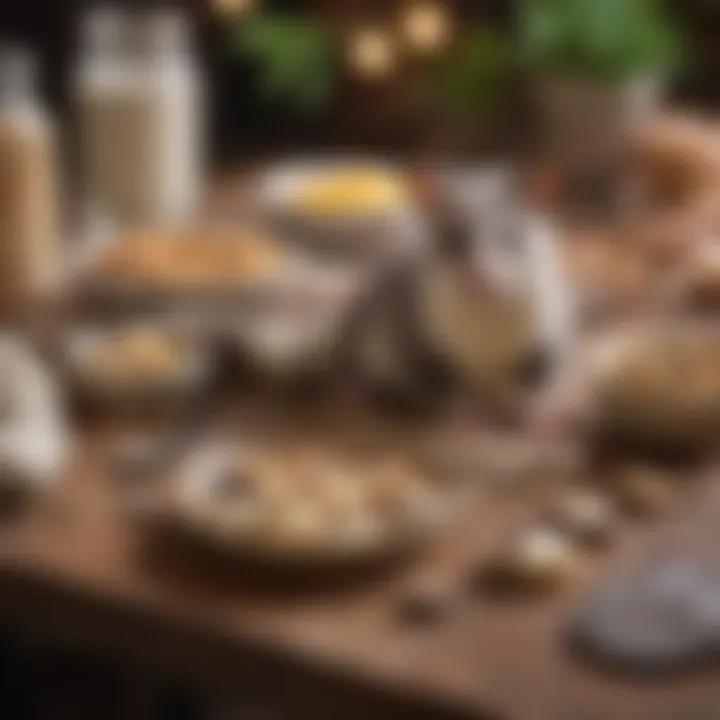
Feeding Practices for Sugar Gliders
Feeding practices are critical in maintaining the health and well-being of sugar gliders. A proper feeding regimen ensures these unique pets receive balanced nutrition. It also helps pet owners avoid common dietary pitfalls that can arise from misunderstanding feeding needs. Knowledge of how and when to feed can lead to happier and healthier sugar gliders. This section will cover essential feeding frequency, signs of overfeeding and undernourishment, and guidance on creating an effective feeding schedule.
Feeding Frequency and Portions
Feeding frequency and appropriate portions are essential components in the diet of sugar gliders. Ideally, sugar gliders should be fed on a daily basis. They are nocturnal animals and consume food during the night, so feeding them at dusk aligns with their natural habits.
The portion size largely depends on their age, weight, and overall activity levels. Young sugar gliders typically require more food than adults. A general guideline for adult sugar gliders is to provide 1 to 2 tablespoons of food per feeding. It is important to measure portions accurately to avoid overfeeding.
- Check weight regularly: This helps monitor if portion sizes are appropriate.
- Adjust based on activity: If your sugar glider is more active, consider increasing portions slightly.
Signs of Overfeeding and Undernourishment
Recognizing signs of overfeeding and undernourishment is vital for sugar glider care. Overfeeding can lead to obesity, which may result in serious health issues, while undernourishment can weaken their immune system and vital functions.
Signs of Overfeeding:
- Increased body weight: Frequent weighing can help detect rapid weight gain.
- Lethargy: Sugar gliders may become less active if they are overfed.
- Lack of interest in food: If they are not eating as eagerly as before, it could indicate they are full.
Signs of Undernourishment:
- Weight loss: Noticeable weight loss can be alarming.
- Weakness: Sugar gliders may appear weak or less responsive.
- Excessive hunger: An unusually eager response to feeding can indicate a lack of sufficient nutrition.
It is essential to stay vigilant of changes in behavior and weight as they can indicate underlying dietary issues.
Creating a Feeding Schedule
Establishing a feeding schedule is an effective way to maintain good health in sugar gliders. Consistency helps regulate their metabolism and overall behavior. A feeding schedule can be set with the following considerations:
- Feeding Time: Best done at dusk, aligning with their natural habits.
- Meal Variety: Include a mix of protein, fruits, and vegetables every day.
- Monitor Changes: Observe any changes in eating patterns and adjust the schedule accordingly.
A suggested sample schedule might look like:
- 6 PM: First feeding session with a balanced diet.
- Midnight: Optional small snack.
- 6 AM: Final feeding session before they settle down for the day.
In summary, by following appropriate feeding practices, pet owners will help ensure that their sugar gliders thrive in a home environment. Maintaining a regular feeding schedule, keeping an eye on portion sizes, and recognizing the signs of dietary issues could mean the difference between a healthy pet and potential health problems.
Common Dietary Mistakes
Understanding common dietary mistakes is crucial for sugar glider owners. Improper nutrition can lead to serious health issues for these small marsupials. This section highlights several key areas where pet owners often falter. Being aware of these pitfalls allows for better decision-making and ultimately healthier pets.
Avoiding Inappropriate Foods
Sugar gliders have specific dietary needs. Some foods are harmful or even toxic to them. It is vital to avoid foods that are high in fat, salt, or sugar. For instance, feeding sugary human snacks can lead to serious health problems, such as obesity and diabetes. Additionally, certain foods like chocolate, caffeine, and avocados should never be given, as they are toxic.
It is essential to stick to a diet that mimics what sugar gliders would eat in the wild. This includes a mix of fruits, vegetables, and protein sources. It's advisable to research and consult reliable sources about what foods are appropriate.
Understanding Sugar and Its Effects
Sugar is a significant concern for sugar glider diets. While these animals may seem to have a high tolerance for sweet foods, excessive sugar can lead to health complications. High sugar intake can cause metabolic issues, leading to obesity. This is a growing problem among pet sugar gliders.
Monitoring their sugar intake is just as important as providing essential nutrients. Instead of sugary treats, opt for fruits with lower sugar content, like berries. Always remember that moderation is key. Natural sugar from fruits is acceptable, but any added sugars must be avoided.
Neglecting Hydration Needs
Hydration is often overlooked when considering the dietary needs of sugar gliders. Just like any other animal, sugar gliders require access to clean, fresh water. Many owners may not recognize the signs of dehydration. Lack of water can impact their overall health, leading to lethargy or other serious complications.
To ensure proper hydration, consider providing water via a shallow dish or a water bottle. Check the water daily to keep it clean. It's also valuable to include water-rich fruits and vegetables in their diet. Foods like cucumbers and watermelon can help maintain their hydration levels.
Proper hydration is fundamental to the health of sugar gliders. Always provide access to fresh water and include hydrating foods in their diet.
Recipes for Sugar Glider Meals
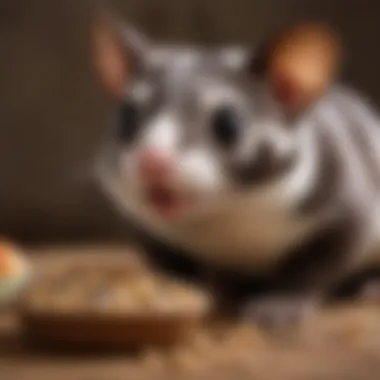
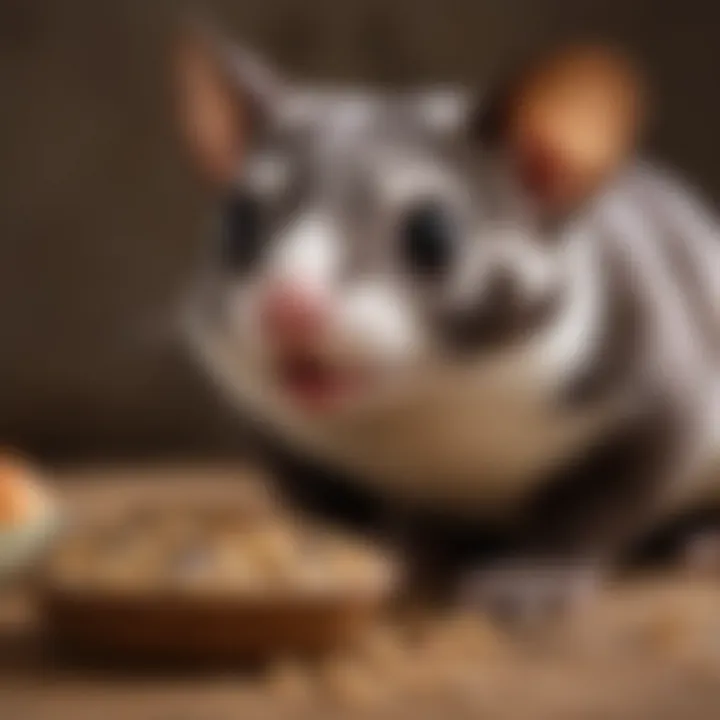
Creating suitable meals for sugar gliders is key to their health and happiness. Pet owners need to understand the dietary requirements and preferences of these creatures. A well-balanced diet will not only ensure longevity but also enhance their overall well-being. Sugar gliders thrive on a variety of foods. Therefore, these recipes will focus on maintaining a balanced diet, offering tasty treats, and ensuring necessary nutrients are included. Just as important as what they eat is how their diet is structured, and this section will provide practical guidance on preparing meals that meet their unique dietary needs.
Balanced Diet Recipe Ideas
A balanced diet is crucial for sugar gliders. Their meals should include proteins, carbohydrates, fats, vitamins, and minerals in the right proportions. Here are a couple of recipe ideas that align with these requirements:
- Protein-Rich Glider Mix: Combine cooked chicken, mashed eggs, and a small amount of low-fat yogurt. This mixture provides essential protein and maintains a healthy gut flora.
- Nutri-Veggie Blend: Mix green leafy vegetables like spinach with sweet potatoes and carrots. Ensure these are finely chopped or mashed to facilitate consumption.
These meals not only nourish but can also be prepared in batches and stored for convenience.
Fruits and Vegetables Combos
Fruits and vegetables are significant components of a sugar glider's diet. They provide the necessary vitamins and hydration. Here are some appealing combinations:
- Fruit Medley: Blend together banana, apple, and blueberries with a splash of water for smoothness. This mixture is not only delicious but appealing to their sweet tooth.
- Veggie Crunch: Shredded zucchini, carrots, and bell peppers make for a crunchy delight. Providing variety in texture promotes interest in food.
It is important to research which fruits and vegetables offer the best health benefits while avoiding toxic varieties.
Homemade Protein Options
Protein sources are vital for muscle development and energy. Here are some options:
- Cooked Chicken: Shredded and mixed with some easy digestible grains will delight your pet.
- Cottage Cheese: A low-fat option that can be given with fruits like peaches or pears.
Using these protein options ensures that sugar gliders stay energetic and active.
Snacks and Treats for Sugar Gliders
Occasional snacks and treats can be used for training and bonding. However, moderation is key to prevent obesity. Ideas include:
- Nut Treats: Offer small pieces of unsalted almonds or walnuts. A little goes a long way.
- Dried Fruits: Raisins or apple chips can be occasional treats but should be given sparingly due to high sugar content.
Remember, treats should not exceed 10% of their total diet to avoid health risks.
Regularly monitor the health of your sugar glider to ensure their diet remains balanced and appropriate based on age and activity level.
Crafting these recipes not only ensures nutritional adequacy but also offers an opportunity to bond with your sugar glider. Engaging them in mealtime can enrich their lives and foster a strong relationship.
Monitoring Health Through Nutrition
Monitoring the health of sugar gliders through nutrition is essential for their well-being. These small marsupials have specific dietary needs, and meeting those needs is crucial to prevent health issues. Pet owners must be attentive and proactive in observing their sugar gliders' health, as diet directly influences their behavior, energy levels, and overall vitality.
A well-balanced diet can prevent many dietary-induced health problems. By knowing the signs of unbalanced nutrition, pet owners can act swiftly, making necessary dietary adjustments. In addition, understanding how to tailor diets through different life stages allows for better management of their health. Knowledge about the impact of various foods on the body helps in making informed choices. This approach to nutrition fosters a healthier and more vibrant life for these creatures.
Recognizing Dietary-Induced Health Issues
Various health issues can arise from improper nutrition in sugar gliders. Common signs include lethargy, dull fur, and changes in behavior. Some sugar gliders may also exhibit digestive problems or sudden weight changes. Awareness of these symptoms is vital for pet owners. A balanced diet supports not only physical health but also mental well-being.
Sugar gliders that are not receiving adequate nutrients may face serious conditions such as metabolic bone disease. This disease stems from calcium deficiency. When owners notice any signs of health issues, they should evaluate their diet immediately. Consulting with a veterinarian when health concerns arise is also a recommended step.
"Prevention is better than cure. Monitoring nutrition helps in catching problems early."
There are numerous dietary factors that can lead to health issues:
- Insufficient protein intake
- Imbalance in calcium and phosphorus
- Excessive sugar consumption
- Lack of hydration
Being aware of these points can make a significant difference in the health of a sugar glider. Regular monitoring allows owners to adjust their pets' diets as needed.
Adjusting Diet Based on Life Stage
Sugar gliders experience various life stages, each requiring different nutritional needs. For example, young sugar gliders, or joeys, need high protein and calcium-rich diets to support their growth. Adults, however, may require more balanced diets, reflecting their less active lifestyles unless they are breeding.
Senior sugar gliders might need softer foods due to dental issues and can benefit from easily digestible proteins. Owners should tailor their approach by considering these life stages. Adjustments can help maintain the energy levels and overall health of their pets.
A few tips for adjusting diets include:
- Increase protein during growth phases.
- Monitor weight changes in older sugar gliders.
- Ensure hydration is always available, especially in play and breeding seasons.
In summary, understanding dietary needs based on life stages helps in delivering optimal nutrition. Owners must be flexible and responsive in their feeding strategies. Consistency in monitoring and adjustments can promote a healthy life for sugar gliders.







